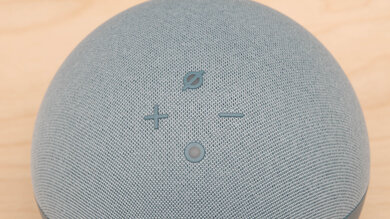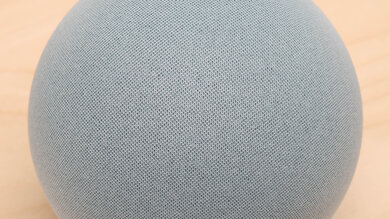The Amazon Echo Gen 4 is a small, spherical speaker with built-in Alexa capabilities. You can activate Alexa using your voice or with a button on the speaker, and it has a built-in Zigbee hub that lets you control compatible smart home devices like light switches. There's a mute microphone button to control when the speaker is listening to you. However, because it's powered by AC, it isn't suitable to bring outdoors. This small speaker can't fill large rooms with sound but gets loud enough for the average living room.
Our Verdict
The Amazon Echo is passable for music. Out-of-the-box, its sound profile is a bit boomy, and higher frequencies sound veiled and dark. Like many small speakers, it also lacks low-bass, so you don't feel the deep thump in bass-heavy music genres. There are bass and treble adjustments to help you customize its sound to your liking, which is nice. However, this speaker can't get very loud, which might be disappointing if you want to use it for music.
- Bass and treble adjustments.
- Not quite loud enough for large rooms.
The Amazon Echo is mediocre for videos and movies. It's not meant for setting up alongside your TV and has a boomy, dark sound profile. It lacks low-bass, so you don't feel the deep rumble in action-packed scenes. It doesn't get very loud, either. On the upside, its latency with Android and iOS devices is low, so you won't notice much audio lag if you use it to watch an occasional video on your phone.
- Bass and treble adjustments.
- Not quite loud enough for large rooms.
- Lacks low-bass.
The Amazon Echo is acceptable for podcasts. Its balanced mid-range can reproduce voices clearly, though speech in higher frequencies can sound a bit veiled. It doesn't get very loud either, and some compression artifacts are present when you play it at max volume. On the upside, it has a Multi-Room feature, so you can pair two Echo speakers and bring your podcast from one room to the next.
- Bass and treble adjustments.
- Not quite loud enough for large rooms.
The Amazon Echo is amazing for voice assistant support. It has built-in Amazon Alexa capabilities, which you can activate using your voice. The speaker can understand you even if you aren't very close to it or in a noisy environment. You can also mute the microphone when you don't want it to hear you, and there's a built-in Zigbee hub you can use to control compatible smart home devices like lightbulbs and thermostats across your home.
- Built-in Alexa support.
- Mic mute button.
- Not quite loud enough for large rooms.
The Amazon Echo has to be plugged into an outlet to work, so it isn't suitable for outdoor use.
Changelog
- Updated Aug 28, 2023: Made minor edits to the text to bring it up to date.
- Updated Aug 22, 2023: Added market comparison with the Amazon Echo Pop in the Portability box.
- Updated Feb 28, 2023: Added a market comparison for the Apple HomePod (2nd generation) to the Frequency Response Accuracy box.
- Updated Feb 09, 2022: Updated the text to provide information regarding Dolby Audio.
Check Price
Differences Between Sizes And Variants
This speaker comes in several color variants: 'Glacier White', 'Twilight Blue', 'Charcoal', and a special edition in collaboration with the global health charity 'PRODUCT(RED)'. We tested the 'Twilight Blue' variant; you can see the label for the model we tested here. We expect other color variants to perform similarly.
If you come across another version, let us know in the forums.
Popular Speaker Comparisons
The Amazon Echo is a small speaker with built-in voice assistant capabilities. It has a similar design to the smaller and more budget-friendly Amazon Echo Dot Gen 4, but a better-balanced sound profile and a more extended low-bass for music-listening and watching videos. You can activate Alexa using your voice, which it does an excellent job of picking up, even if you're far away or in a noisy place. Like the Amazon Echo Studio (1st generation), it has a built-in Zigbee hub to control compatible smart home devices like lightbulbs and thermostats across your home. However, like many small speakers, it doesn't get very loud.
For other recommendations, check out the best home Bluetooth speakers, the best small speakers, and the best Bluetooth speakers.
The Amazon Echo Gen 4 and the Amazon Echo Dot Gen 4 are both excellent voice assistant speakers; however, the Echo is a better choice for listening to music. The Echo has a better-balanced sound profile out-of-the-box, and it can reproduce a more extended low-bass. Also, it gets louder, though it has some more compression at max volume. It's a bit bigger than the Echo Dot, too.
Depending on your listening habits, you may prefer either the Amazon Echo Gen 4 or the Apple HomePod (2nd generation). Both smart speakers offer excellent voice assistant support through their respective assistants. Only the Amazon speaker can playback stereo content without downmixing it to mono, and its bass and treble adjustments make it more customizable overall. That said, the Apple speaker brings more rumble in the low-bass, which is great for fans of EDM and hip-hop.
The Amazon Echo Gen 4 is a better voice assistant speaker than the Apple HomePod mini. The Amazon has better ambient noise performance, so it can understand you more clearly in noisy settings. It also comes with bass and treble adjustments to customize its sound and can produce a deeper bass than the Apple. It comes with built-in Alexa, but if you prefer Siri, go for the Apple instead.
The Amazon Echo Gen 4 and the Google Nest Audio have very similar performances, but the Amazon speaker is a better choice for voice assistants. The Amazon speaker does a better job of understanding your voice in noisy environments, and it also has lower latency with iOS and Android devices over a Bluetooth connection. However, the Google speaker supports Google Chromecast, unlike the Amazon model.
Test Results

It's a small speaker with a distinctive spherical design. It looks very similar to the Amazon Echo Dot Gen 4, but it's a bit bigger. It sits on its base, and a ring of light surrounds the base of the speaker. The lights activate with voice commands, volume adjustments, and when you turn the microphone off. However, it doesn't flash when you play music, and you can't control the colors it displays.
This speaker is powered by AC, so you have to plug it into a wall outlet for it to work. As a result, it can't be brought outdoors as easily as battery-powered speakers like the Bose SoundLink Micro. It's pretty small, but the Amazon Echo Pop is a good alternative if you want something smaller.
The build quality is unremarkable. The speaker feels solid, and the fabric that wraps around it is tight and doesn't seem like it could rip easily. However, it doesn't have an advertised IP rating for dust or water resistance, so be careful if you plan to use it around water.
The physical controls are simple but quite limited. There are four buttons, and you can tap the front of the speaker to snooze an alarm. The base of the speaker and mute button both glow red when the mic is muted. However, you can't play or pause audio or skip a song with the speaker controls.
It has fair frequency response accuracy. Its sound profile is a bit boomy and dark. Like many small speakers, it struggles to reproduce low-bass, so you won't get the deep rumble in bass-heavy genres like EDM, similar to the Apple HomePod (2nd generation). However, overemphasis in the high-bass adds boominess and clutters mixes. Voices and instruments are present and understandable but are also somewhat veiled. You can use the bass and treble adjustments in the Amazon Alexa app to help customize its sound to your liking.
Note: This speaker comes with Dolby Audio built-in, which tunes and enhances your audio. This feature can't be disabled and is different from Dolby Atmos, which is a virtual surround sound feature supported on another Amazon speaker, the Echo Studio.
The soundstage is very good. It plays stereo content, so you can hear a separation between left and right channels with content recorded in stereo. It has decent directivity, but audio sounds a bit different depending on which direction the speaker is facing. For that reason, it's more suitable for use on a shelf or desk in front of a wall instead of in the middle of the room during a gathering.
It has middling dynamics. It doesn't get very loud, and some compression is present at maximum volume. It's not ideal for crowded parties or large rooms, but it does get loud enough to fill an average living room with sound.
It has no battery, and you must plug it into a wall socket to work. According to the manufacturer, it enters a low-power mode when not in use to help reduce its energy consumption.
This speaker has exceptional voice assistant support. Amazon Alexa is built-in, and you can activate it with voice commands or physical controls. The speaker can understand you even if you're far away or in a noisy setting. You can even mute the mic when you don't want the speaker to hear you.
The Amazon Alexa app is fantastic. It features a 3-band EQ to adjust the speaker's sound profile. You can connect another Echo speaker and make a speaker pair, which helps create a larger soundstage. Also, the Party Mode and Multi-Room features let you connect multiple speakers and play music across a large area or throughout multiple rooms in your house.
This speaker has a 3.5mm AUX port, which you can use to wire your smartphone directly to it to play audio.
It has good Bluetooth connectivity. It doesn't support multi-device pairing, so you have to repair it when switching devices. However, its latency is quite low with iOS devices and even lower with Android devices, so it's suitable for watching videos on your phone. Some apps and devices compensate for latency, so your experience might vary.
This speaker is Wi-Fi compatible. However, it doesn't support Apple AirPlay or Google Chromecast connectivity; this is disappointing if you already own products in the Apple or Google ecosystem and want an easy way to stream audio from your phone or computer through the speaker.







